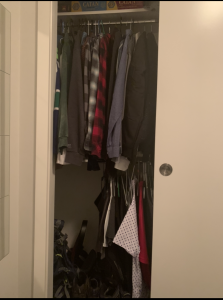Annie Leonard set out in 2007 to tell a simple but dire truth: the materials economy is linear while the Earth is finite. Those two realities cannot coexist in perpetuity, and if things don’t change, humanity will bleed the planet dry. This was the message behind The Story of Stuff . One key and crucial point that Leonard aimed make plainly clear is that consumption isn’t an issue; people need to consume goods in order to survive. Rather, consumer culture that focusses on consumption beyond what is required is at the root of the vast majority of societal issues.
80% of the world’s resources are consumed by 20% of the world’s population. American’s on average consume 52% more materials than the European average. Average daily calorie consumption has increased by 25% over the last 40 years.
I apologize for the data dump, but while these numbers are difficult to look at, they are far from hard to believe. To illustrate the point, let’s take a look at my closet!
 Upon a quick inventory check, I can confirm that I have an issue. I own 6 plaid shirts, 12 dress shirts, 4 sweaters, and at least a dozen t-shirts. In terms of pants, between all the different varieties a generous count would put me at 8. However, I think that my most horrifying discovery was in my foot wear collection. As I have mentioned on several occasions, I wear Blundstones on 80% of days. Despite that self-recognition, I own 4 pairs of running shoes, two hiking boots, and three casual shoes.
Upon a quick inventory check, I can confirm that I have an issue. I own 6 plaid shirts, 12 dress shirts, 4 sweaters, and at least a dozen t-shirts. In terms of pants, between all the different varieties a generous count would put me at 8. However, I think that my most horrifying discovery was in my foot wear collection. As I have mentioned on several occasions, I wear Blundstones on 80% of days. Despite that self-recognition, I own 4 pairs of running shoes, two hiking boots, and three casual shoes.
I’m not happy with myself here. I have always considered myself to be a conscious consumer, rarely purchasing clothing that I didn’t need. However, some reflection reveals that isn’t true. I’m the problem, and not to throw you under the bus but I’m willing to bet you are too. My roommate (Ben) is the model to look after here. I frequently poke fun at the fact that his staple clothing can be seen in pictures from a decade ago. He’s doing it right! I would urge us all to reflect on excess in our lives. As for me… it’s time for an identity crisis.
NipuniAmaratunga
March 24, 2021 — 5:27 pm
Hi Bryce! I could not help but look at my closet while reading this and while it is not easy to admit, I could definitely be consuming less. I often fall for the thinking that sustainable clothes are more expensive which in retrospect, reminds me of what we heard from our first client challenge: while the upfront cost might be higher, the long-term cost is lower.
Today, we are fortunate to have companies like Uniqlo who do a great job of creating sustainable clothing lines. With sustainable clothing becoming more accessible, I hope that consumers (myself included!) start placing a higher value on the long-term savings than the short-term costs.